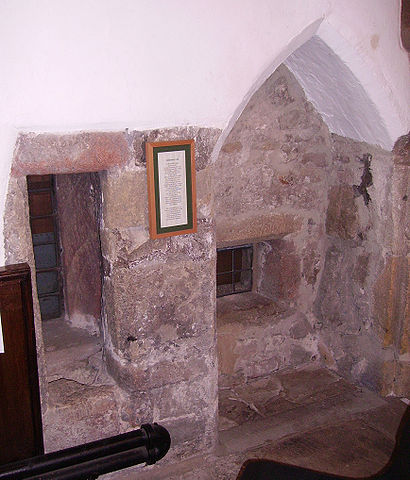
What is an anchorite? An anchorite or an anchoress were people who were walled into a small cell built into a church so that they could carry out a life of prayer and religious contemplation. Anchorites were men and anchoresses were women. The great majority of anchorites were actually women. Studies of the archives have shown that there were 780 anchorites in the UK since records began and over 60% of them were women. The word “anchorite” comes from a Greek word that means “to withdraw”.
Some people have always wanted to devote their lives to religion. There are over 4,000 religions currently recognized in the world and there have been many more throughout human history. People have followed these religions, become preachers for these religions, but some people have always wanted to go the extra mile and devote themselves entirely to a religion.
In the Christian religion, there are monks and nuns who devote their whole life to the church and to God, but some would see that as not going far enough. Monks are devoted to God, but they interact with other people, and they can have a relatively normal life. Some people wanted to both devote themselves to God and overcome the weaknesses of the flesh. These people often became hermits. They would live somewhere remote, avoid people, and spend all of their life in prayer. They would survive through the generosity of people.
The first Christian hermit was Paul of Thebes, who lived in the 3rd Century. He is supposed to have lived alone in the desert of Thebes from the age of sixteen to the age of 135. He is said to have lived in a cave and only eaten the food from a nearby palm tree for 43 years, until a raven started to bring him food. Whether you believe this or not doesn’t matter. He is the first in a long line of hermits, but he was not an anchorite.
Anchorites are people who renounce the world in order to better know God. Unlike hermits, they decide to spend all of their lives in a cell to avoid earthly distractions. These cells were very small and often the anchorite was walled in. They were called anchorholds. They were usually connected to a church, but not always, and they would have three windows. The first window would face into the church and would allow the anchorite to see the altar. This window was called a “squint”. The second window would be a hatch that food could be passed through. The third window might point up to allow light in. They usually had a toilet bucket that they could pass out through the second window as well. The anchorholds were very basic, and the anchorite was expected to spend most of their time in prayer or reading religious texts. The cells were usually not heated because the anchorite was supposed to suffer to help them understand Christ’s suffering.
Not just anybody could be an anchorite. The person had to undergo several interviews with the church before they were accepted. There were stories of people going mad and killing themselves, so the church had to make sure the person was both willing and able to go through with it. If the person was young, they were committing to spending decades in this cell. Once they had been accepted, they would prepare themselves and then they would go through a ritual that was akin to a funeral rite because they were dying in this world in order to be born again in the new one. Then they would enter their cell and the doorway would be bricked up. The anchorites would survive through the charity of local people. They could be talked to through one of the windows, and they often got a reputation for wisdom. Although, the churches didn’t allow them to talk too much.
The number of anchorites appears to have peaked in the 13th century and then it began to decline. The number fell to almost zero after the reformation in England when King Henry VIII destroyed the monasteries. However, anchorites were present in other countries, and they won’t only attached to churches. Anchorholds have been found attached to hospitals, bridges, in cemeteries, and connected to city walls. It was a very extreme way of showing devotion. And this is what I learned today.
Image By –Immanuel Giel 12:05, 16 August 2007 (UTC) – Self-photographed, Public Domain, https://commons.wikimedia.org/w/index.php?curid=2571161
Sources
https://www.bl.uk/medieval-literature/articles/the-life-of-the-anchoress
https://www.thecollector.com/medieval-anchorites-immured-walled-up-alive/
https://www.buildingconservation.com/articles/anchorites/anchorites.htm
https://en.wikipedia.org/wiki/Anchorite
